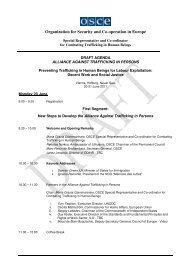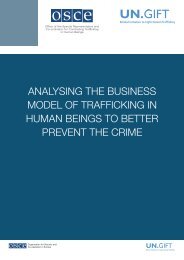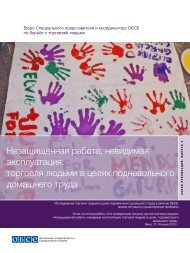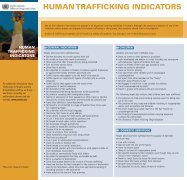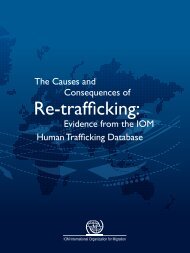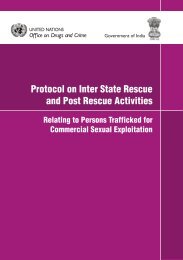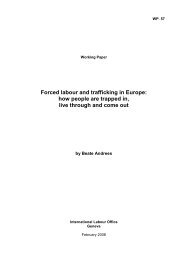An Introduction to Human Trafficking - United Nations Office on ...
An Introduction to Human Trafficking - United Nations Office on ...
An Introduction to Human Trafficking - United Nations Office on ...
Create successful ePaper yourself
Turn your PDF publications into a flip-book with our unique Google optimized e-Paper software.
SUMMARIES OF THE PAPERS<br />
Preventi<strong>on</strong> initiatives in areas of origin have primarily taken the form of<br />
informati<strong>on</strong>/awareness-raising campaigns alerting people of the dangers involved in seeking<br />
work abroad, the promoti<strong>on</strong> of income-generating activities, formal and n<strong>on</strong>-formal<br />
educati<strong>on</strong>al initiatives and initiatives targeted at groups that are known <str<strong>on</strong>g>to</str<strong>on</strong>g> be at high risk<br />
of being trafficked. Some preventi<strong>on</strong> programmes have taken the form of measures <str<strong>on</strong>g>to</str<strong>on</strong>g><br />
strengthen social protecti<strong>on</strong>.<br />
Although the industrialized States <str<strong>on</strong>g>to</str<strong>on</strong>g> which people are trafficked have invested m<strong>on</strong>ey<br />
principally in preventi<strong>on</strong> in the countries of origin, they have also begun <str<strong>on</strong>g>to</str<strong>on</strong>g> make efforts<br />
within their own countries, primarily in the form of revisi<strong>on</strong> and comprehensive implementati<strong>on</strong><br />
of immigrati<strong>on</strong> and employment policies. M<strong>on</strong>i<str<strong>on</strong>g>to</str<strong>on</strong>g>ring working c<strong>on</strong>diti<strong>on</strong>s,<br />
notably in the informal ec<strong>on</strong>omic sec<str<strong>on</strong>g>to</str<strong>on</strong>g>rs, regulating recruitment agencies in sec<str<strong>on</strong>g>to</str<strong>on</strong>g>rs where<br />
trafficking occurs, providing facilities <str<strong>on</strong>g>to</str<strong>on</strong>g> protect migrants from abusive practices and using<br />
legislati<strong>on</strong> <str<strong>on</strong>g>to</str<strong>on</strong>g> address the demand for the labour or services of a trafficked pers<strong>on</strong> are<br />
some of the <str<strong>on</strong>g>to</str<strong>on</strong>g>ols States have used <str<strong>on</strong>g>to</str<strong>on</strong>g> address demand. Countries of destinati<strong>on</strong> have also<br />
implemented large-scale informati<strong>on</strong> campaigns <str<strong>on</strong>g>to</str<strong>on</strong>g> inform the public about the potential<br />
for abusive practices in their countries.<br />
Protecti<strong>on</strong> and assistance<br />
Internati<strong>on</strong>al guidelines now clarify the rights of trafficked pers<strong>on</strong>s under existing internati<strong>on</strong>al<br />
law, in particular their rights <str<strong>on</strong>g>to</str<strong>on</strong>g> protecti<strong>on</strong> and assistance. Intergovernmental agencies<br />
and n<strong>on</strong>-governmental organizati<strong>on</strong>s have issued a range of good practice guidelines<br />
c<strong>on</strong>cerning assistance and care so that identified trafficked pers<strong>on</strong>s can be transferred <str<strong>on</strong>g>to</str<strong>on</strong>g><br />
a safe place <str<strong>on</strong>g>to</str<strong>on</strong>g> receive a variety of services, including physical and psychological care,<br />
legal assistance, shelter and protecti<strong>on</strong>. Significant efforts have also been made <str<strong>on</strong>g>to</str<strong>on</strong>g> develop<br />
standards for the special care of children.<br />
The treatment of trafficked pers<strong>on</strong>s in countries of exploitati<strong>on</strong> varies widely from country<br />
<str<strong>on</strong>g>to</str<strong>on</strong>g> country. Restricti<strong>on</strong>s <strong>on</strong> the definiti<strong>on</strong> of a trafficking pers<strong>on</strong> (women trafficked for<br />
commercial sexual exploitati<strong>on</strong>, for example) can leave other trafficked pers<strong>on</strong>s without<br />
any legal recourse. In many places, trafficked pers<strong>on</strong>s remain criminalized for their illegal<br />
entry in<str<strong>on</strong>g>to</str<strong>on</strong>g> or residence in the countries of transit and destinati<strong>on</strong> or for their involvement<br />
in illicit activities that were a direct c<strong>on</strong>sequence of their being trafficked. The<br />
c<strong>on</strong>sequence of inadequate identificati<strong>on</strong> procedures usually means that a trafficked pers<strong>on</strong><br />
will be summarily returned <str<strong>on</strong>g>to</str<strong>on</strong>g> his or her country of origin without any attenti<strong>on</strong> <str<strong>on</strong>g>to</str<strong>on</strong>g><br />
potential risks at home.<br />
Recovery for trafficked pers<strong>on</strong>s is a l<strong>on</strong>g and complex process. Less<strong>on</strong>s learned reveal<br />
that the c<strong>on</strong>venti<strong>on</strong>al assumpti<strong>on</strong> that victims should be repatriated and returned <str<strong>on</strong>g>to</str<strong>on</strong>g> live<br />
with their families is inappropriate and results <str<strong>on</strong>g>to</str<strong>on</strong>g>o easily in victims being returned <str<strong>on</strong>g>to</str<strong>on</strong>g> a<br />
situati<strong>on</strong> where they suffer further harm.<br />
13





